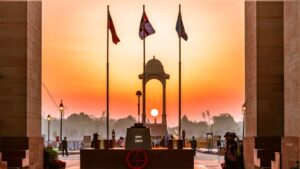Published on: January 22, 2022
AMAR JAWAN JYOTI AND NATIONAL WAR MEMORIAL FLAME
AMAR JAWAN JYOTI AND NATIONAL WAR MEMORIAL FLAME
NEWS
The government has put out the eternal flame of the Amar Jawan Jyoti underneath India Gate and merged it with the one instituted at the National War Memorial in 2019
AMAR JAWAN JYOTI
- Underneath India Gate in central Delhi

- Established in 1972
- Was to mark India’s victory over Pakistan in the 1971 War, which resulted in the creation of Bangladesh
- The then Prime Minister Indira Gandhi had inaugurated it on Republic Day 1972, after India defeated Pakistan in December 1971.
- Key elements – Black marble plinth, a cenotaph, which acted as a tomb of the unknown soldier.
- Plinth had an inverted L1A1 self-loading rifle with a bayonet, on top of which was a soldier’s war helmet.
- The installation had four urns on it, with four burners. On normal days one of the four burners were kept alive, but on important days like the Republic Day, all four burners were lit. These burners were what is called the eternal flame, and it was never allowed to be extinguished.
- The India Gate, All India War Memorial, as it was known earlier, was built by the British in 1931. It was erected as a memorial to around 90,000 Indian soldiers of the British Indian Army, who had died in several wars and campaigns till then. As it was a memorial for the Indian soldiers killed in wars, the Amar Jawan Jyoti was established underneath it by the government in 1972.
National War Memorial
- Inaugurated by Prime minister in February 2019
- Built to commemorate all the soldiers who have laid down their lives in the various battles, wars, operations and conflicts of Independent India. Final design of the memorial was selected through a competition.
- The architecture of the memorial is based on four concentric circles.
- Largest is the Raksha Chakra or the Circle of Protection which is marked by a row of trees, each of which represent soldiers, who protect the country.
- The Tyag Chakra, the Circle of Sacrifice, has circular concentric walls of honour based on the Chakravyuh.
- The walls have independent granite tablets for each of the soldiers who have died for the country since Independence.
- As of today, there are 26,466 names of such soldiers on these granite tablets etched in golden letters. A tablet is added every time a soldier is killed in the line of duty.
- This Veerta Chakra, the Circle of Bravery, has a covered gallery with six bronze crafted murals depicting the battles and actions of our Armed Forces.
- The final is the Amar Chakra, the Circle of Immortality, which has an obelisk, and the Eternal Flame.
- The flame from the Amar Jawan Jyoti at the India Gate will be merged with this flame, which has been kept burning since 2019 when the memorial was unveiled.
- The flame is a symbol of the immortality of the spirit of the fallen soldiers, and a mark that the country will not forget their sacrifice.
- Busts of the 21 soldiers who have been conferred with the highest gallantry award of the country, Param Vir Chakra, are also installed at the memorial.


Super 🔥